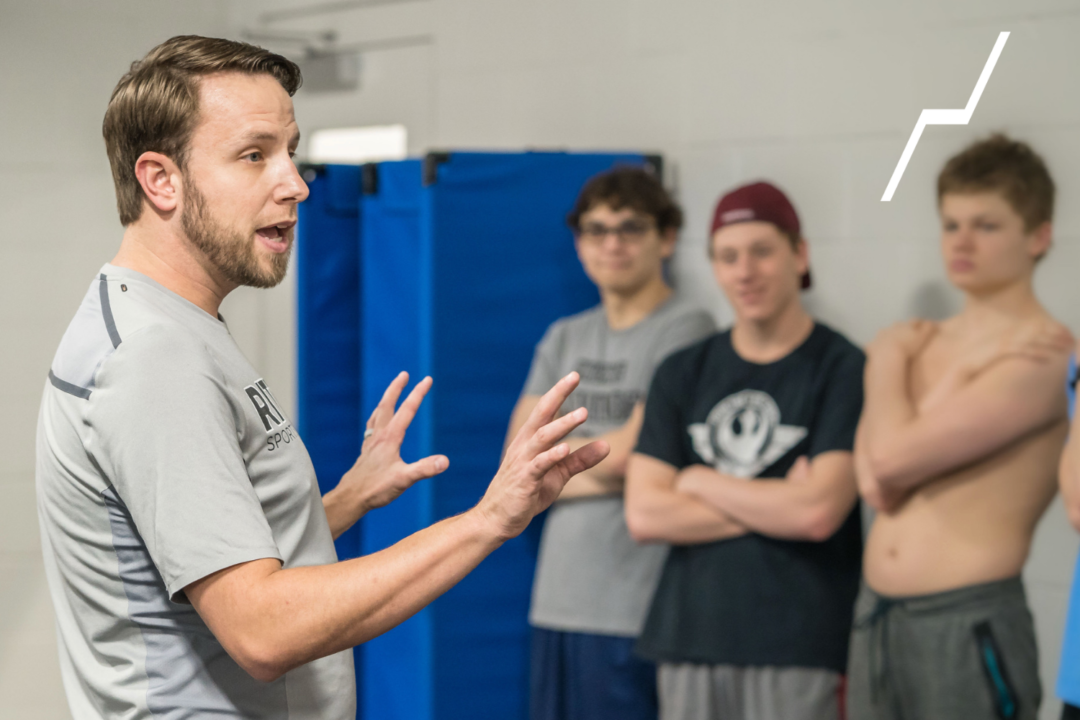Dryland games for swimmers are an essential part of dryland plans for all ages. For youth athletes, they can be the foundation of dryland. For older athletes, they are a tool for building cohesion within a team. When games are implemented appropriately, they train coordination, rhythm, body awareness, reaction time, strength, balance, power, and overall athleticism. They also keep swimmers engaged and prevent them from burnout, especially as yardage in the pool becomes tedious mid-season. In addition, games develop basic abilities in your athletes that they will use in everyday life such as leadership, coach-ability, and social skills. There are endless possibilities to the games you can create. We hope these 12 games from the SURGE Strength Dryland Certification Curriculum will inspire you as a coach to feel more comfortable with games as a fun way to elevate your dryland training.
Dryland Games for Swimmers #1 – World Domination
The goal of world domination is to stay standing while a designated partner tries to hit your hands and push you off-kilter. An athlete’s stability is challenged as they play “defense” by moving their arms out of the way in attempts to get their partner to fall forward. Core strength is also engaged as an athlete balances and attempts to push their partner. This game works great for high-schoolers as well as for younger children. There is also a single leg variation to make it more challenging. This game works best when athletes are paired with people similar in size. Check out this video of our athletes playing this fun partner-reaction game:
Dryland Games for Swimmers #2 – Obstacle Courses
Obstacle courses are a great way to use equipment, work on level changes (think jumping high or bending low) and allow teams to think about working out differently. These never get old and are versatile from session to session or even round to round. Coaches should break up swimmers into 2 groups and have them race through. If this doesn’t work for your situation, simply let them enjoy working through it. Cones, ladders, balls, boxes, polly dots, mats, or any other object can be used to create a course.
Dryland Games for Swimmers #3 – React Up
React Up is a fun way for coaches to interact in their dryland games. Have swimmers start by laying on the ground face down. On the coach’s cue, have them jump up as fast as possible and land on 1 leg. There are plenty of ways to tailor this game to your level of athletes. For example, you can add a streamline position at the top, or have athletes start on their back and roll before getting up. Coaches may enjoy playfully tricking their athletes as they “false-start” in this game. This helps train reaction time. By the end of this one, swimmers have more awareness of their body positions. It’s also a great way for them to work on stability and balance. See SURGE Strength athletes try this game here:
Dryland Games for Swimmers #4 – Relay Races
This is an unrivaled classic. Swimmers love relays. They also love racing. Put these two together and there’s no better group of athletes to perform relay races! Some examples are simple such as sprinting to a pile of cones and seeing which team can collect the cones the fastest. Others are more complex. For example, divide the group onto 2 sides of the turf and see who can push a weighted sled through all team members the fastest. Relay races require teamwork. Any exercise can be implemented into a relay race making them a great way to get athletes practicing new or familiar skills.
Dryland Games for Swimmers #5 – Push Over
Push Over is a game all about core stiffness and bracing. Partner 1 tries to maintain a “stiff,” solid hollow body position. Partner 2 tries to push them over or log roll them across the floor. The hardest part of this game is trying not to laugh as your partner tries their hardest to push you over. This game also has best results when executed with partners of similar sizes and abilities.
Dryland Games for Swimmers #6 – Floor is Lava
The “Floor is Lava” is a fun game utilizing equipment such as benches or polydots in order to get swimmers across the workout space without touching the floor. This game works on stability and balance as well as strategy while managing various body positions. An added bonus is that it’s easy to scale up and scale down as swimmers age up in their training.
Dryland Games for Swimmers #7 – Red Light, Green Light
Red Light, Green Light is a classic. In this game, coaches call out a color that tells athletes which exercise and at which speed to perform. We choose different colors to represent various exercises at different speeds. This game is tailored to all learning styles and helps athletes understand body control, improves their coach-ability, and teaches gear change through body weight exercises. In addition, each cue represents an exercise that improves the swimmer’s strength and overall athleticism. See how our Red Light, Green Light game plays out with our 11-14-year-old group below:
Dryland Games for Swimmers #8 – 2-Ball Soccer
Two ball soccer is self-explanatory. Divide into 2 teams and mark two goals. Throw in 2 balls to ensure that everyone in the group (even your less coordinated swimmers) get a chance to handle the ball. This game is great for agility, athleticism, and endurance especially for age group swimmers. This is also a fun activity for master’s swimmers or other groups who enjoy playing sports in addition to swimming. Think: we just came back from break and we’re just getting back into it type of situations.
Dryland Games for Swimmers #9 – Simon Says
Simon says is a great way to teach kids how to follow directions and recall movement patterns. Tailoring it for dryland gives swimmers practice with basic exercises and teaches them to react using visual and audio cues. Our version also allows team members to take turns being the leader and giving directions in front of the group. See how we incorporate visual, audio, and kinesthetic learning in our demo videos below:
Dryland Games for Swimmers #10 – Transition of Locomotion
Transition of locomotion is more like an agility drill than a game. However, parameters and rules can easily be added to make it competitive. During this activity, swimmers perform an exercise across the workout space as directed by the coach. On their cue, swimmers change direction or exercise mid-run. For example, the coach directs them to skip. Mid-way across the floor, coaches might clap or blow a whistle signaling the swimmers to turn and skip backwards. This can be done with any movement whether in a standing or crawling position, etc. This game is a great way to practice movement skills and focus swimmers on the movement at hand.
Dryland Games for Swimmers #11 – Single-leg Tag
The game of tag, in general, has many benefits. These include increased agility, endurance, and reaction. However, this variation of tag further challenges your athlete’s balance, stability, and strength. It also makes it harder to be tagged and allows the game to continue in a smaller space. Choose multiple people to be “it” in order to keep the game moving. See how our age groupers handle this fun variation of this timeless game:
Dryland Games for Swimmers #12 – Land Closest to Line
“Land closest to line” is a game that challenges a swimmer’s spatial awareness and body control. As the name suggests, the goal is to see how close the athletes can jump and stick their landing on a marked line. This includes having swimmers jump over lines, one on foot, and starting from various distances away from the line. This game can be shortened as a time filler activity or can act as its own segment in training. “Land closest to line” uses ground reaction forces to develop lower body power. In other words, it helps swimmers develop better starts and turns. But keep in mind that our less coordinated swimmers might find this game challenging!
Conclusion: Dryland Games for Swimmers
Over time, you will get more comfortable with implementing games as part of your regular dryland plan. From there, games will naturally evolve to fit your group. These games have very simple parameters which easily allow you to create your own version of them. Perhaps, they have even sparked your creativity to make up totally new games given your space and equipment. Regardless of which game you choose, make sure you understand the underlying training principles for each session. Every game should focus on at least 1 specific training component such as coordination, balance, strength, or rhythm. Once you know the purpose of your designated game, the possibilities are endless. Above all, don’t be afraid to use games at any age – serious training can be achieved through a bit of fun!
MORE DRYLAND RESOURCES FROM SURGE STRENGTH:
ENROLL IN A DRYLAND 101 COURSE FOR FREE
GET STARTED WITH A DRYLAND PROGRAM
LEARN ABOUT BECOMING SSDC

SURGE Strength’s Mission:
BUILD BETTER ATHLETES
GENERATE FASTER SWIMMERS
Courtesy of SwimSwam’s exclusive dryland training partner, SURGE Strength.
SURGE Strength is swim-specific, strength training by Chris Ritter, whose aim is to build better athletes and faster swimmers through SURGE Strength’s Dryland Programs, Courses and Certification.











